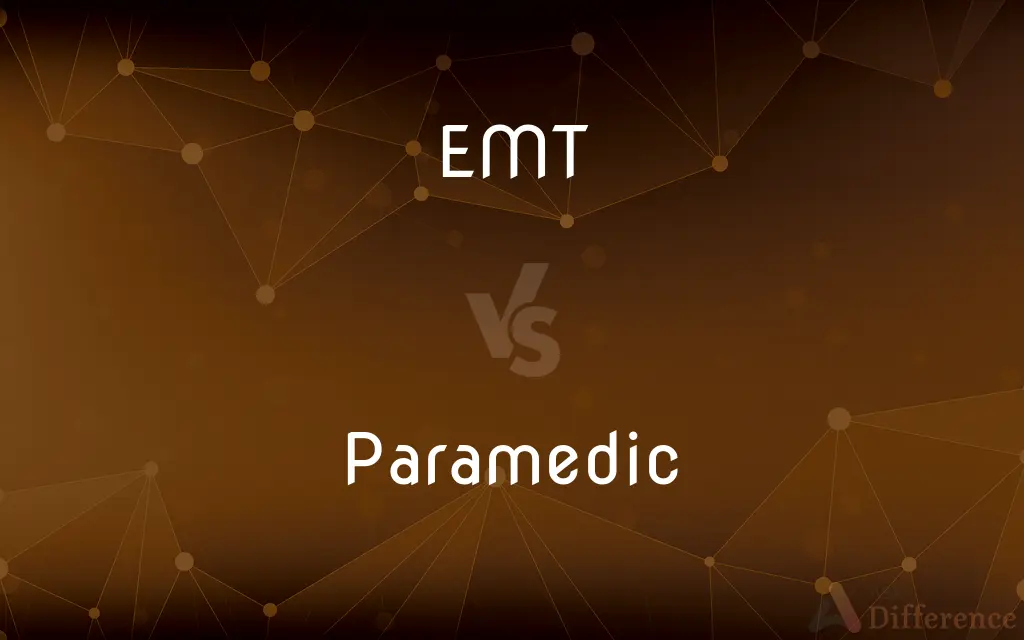EMT vs. Paramedic — What's the Difference?
By Tayyaba Rehman & Fiza Rafique — Published on February 13, 2024
EMTs provide basic emergency medical care and transportation, while Paramedics offer advanced life support, including drug administration and invasive procedures.

Difference Between EMT and Paramedic
Table of Contents
ADVERTISEMENT
Key Differences
EMT (Emergency Medical Technician) and Paramedic roles are critical in emergency medical services, with each position requiring different levels of training and expertise. EMTs provide basic emergency medical care, including patient assessment, CPR, and transportation to medical facilities. Their training focuses on essential life-saving techniques and handling various emergencies, ensuring patient stability during transport.
Paramedics, on the other hand, possess a more advanced skill set, allowing them to perform complex procedures such as administering medications, intravenous infusions, intubation, and reading EKGs. The training for Paramedics is more extensive, often requiring one to two years of specialized education beyond the EMT level, including a deeper understanding of medical terminology, anatomy, and physiology.
The scope of practice is a significant difference between EMTs and Paramedics. While EMTs are equipped to manage respiratory, cardiac, and trauma emergencies at a basic level, Paramedics are prepared to provide more comprehensive pre-hospital care, including advanced airway management and drug administration. This advanced training enables Paramedics to make more autonomous decisions regarding patient care in the field.
In terms of certification, both EMTs and Paramedics must pass rigorous training programs and certification exams. However, the Paramedic curriculum is more demanding, reflecting the higher level of medical care they are authorized to provide. Both roles require continuous education and recertification to ensure that they remain current with the latest in emergency medical care.
Despite the differences in training and scope of practice, both EMTs and Paramedics work closely together within the emergency medical services system to provide critical care in pre-hospital settings. Their collaboration ensures that patients receive the most appropriate level of care from the scene of an emergency to the hospital.
ADVERTISEMENT
Comparison Chart
Level of Care
Basic life support
Advanced life support
Training Duration
Typically 120-150 hours
1,200 to 1,800 hours or more
Skills
CPR, oxygen administration, basic first aid
Intubation, EKGs, administering medications
Decision Making
Follows strict protocols
Can make more autonomous medical decisions
Medical Procedures
Limited to non-invasive
Includes invasive procedures
Compare with Definitions
EMT
A healthcare professional providing basic emergency care.
The EMT quickly administered oxygen to the patient having difficulty breathing.
Paramedic
An advanced healthcare provider in emergency medical services.
The paramedic administered IV fluids to the dehydrated patient.
EMT
Operates under strict protocols in emergency situations.
The EMT followed protocol to stabilize the patient's condition.
Paramedic
Makes critical decisions regarding emergency care.
The paramedic decided to airlift the patient for faster hospital access.
EMT
Certified to handle basic life-threatening situations.
After the CPR course, she became a certified EMT.
Paramedic
Trained in advanced life support techniques.
Paramedics are skilled in performing emergency intubation.
EMT
Trained in rapid response and patient transport.
An EMT arrived at the accident scene to transport the injured to the hospital.
Paramedic
Specializes in comprehensive pre-hospital medical care.
A paramedic's quick action saved the heart attack victim's life.
EMT
The first line of medical response in emergencies.
The EMTs were the first to arrive and assess the patient's needs.
Paramedic
Can administer medications in pre-hospital settings.
The paramedic provided pain relief medication en route to the hospital.
Paramedic
A person who is trained to give emergency medical treatment or assist medical professionals.
Paramedic
An individual trained to medically stabilize people through various interventions, victims of trauma or medical events outside of a hospital setting and preparing them for transport to a medical facility.
Paramedic
(US) An individual who is licensed at the state or national level to practice medical interventions in an emergency pre-hospital setting.
Paramedic
A person trained to assist medical professionals and to give emergency medical treatment
Common Curiosities
How long does it take to become an EMT?
EMT training typically takes 120-150 hours to complete.
What does EMT stand for?
EMT stands for Emergency Medical Technician.
What additional skills do Paramedics have over EMTs?
Paramedics can perform advanced procedures like intubation and administer medications.
Can a Paramedic become an EMT?
A Paramedic inherently has the qualifications of an EMT but operates at a more advanced level.
Do both EMTs and Paramedics work in ambulances?
Yes, both can work in ambulances, providing different levels of medical care.
Can EMTs administer drugs?
EMTs are limited to providing basic care and cannot administer most medications.
Can EMTs transition to becoming Paramedics?
Yes, EMTs can advance to become Paramedics through additional education and training.
Do EMTs need to be certified?
Yes, EMTs must be certified through state-approved training programs and exams.
What is a Paramedic?
A Paramedic is a healthcare professional with advanced training in emergency medical services.
What kind of emergencies do EMTs respond to?
EMTs respond to all types of emergencies, providing basic life support.
What is the main difference in the scope of practice between EMTs and Paramedics?
Paramedics have a broader scope of practice, including advanced life support and invasive procedures.
Are Paramedics authorized to make medical decisions?
Paramedics can make more autonomous decisions regarding patient care in the field.
Is Paramedic training more extensive than EMT training?
Yes, Paramedic training is more comprehensive, often requiring over 1,200 hours of education.
What's the work environment like for EMTs and Paramedics?
They work in various settings, primarily in ambulances and emergency departments, often in high-stress situations.
How often do EMTs and Paramedics need recertification?
Recertification requirements vary by location but generally occur every two to three years.
Share Your Discovery

Previous Comparison
Thanksgiving in America vs. Thanksgiving in Canada
Next Comparison
Jon Stewart vs. Stephen ColbertAuthor Spotlight
Written by
Tayyaba RehmanTayyaba Rehman is a distinguished writer, currently serving as a primary contributor to askdifference.com. As a researcher in semantics and etymology, Tayyaba's passion for the complexity of languages and their distinctions has found a perfect home on the platform. Tayyaba delves into the intricacies of language, distinguishing between commonly confused words and phrases, thereby providing clarity for readers worldwide.
Co-written by
Fiza RafiqueFiza Rafique is a skilled content writer at AskDifference.com, where she meticulously refines and enhances written pieces. Drawing from her vast editorial expertise, Fiza ensures clarity, accuracy, and precision in every article. Passionate about language, she continually seeks to elevate the quality of content for readers worldwide.














































